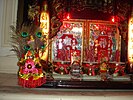Songkran
| Songkran | |
|---|---|
| Official name |
Different names denote the festival across South and Southeast Asia |
| Also called | Southeast Asian New Year |
| Observed by | Thais, Laotians, Cambodians, Sri Lankans, Burmese, Dai, Tai Dam and certain ethnic groups of northeast India |
| Significance | Marks the new year |
| Date | Generally 13/14 April |
| 2016 date | 13/14 April, Monkey |
| 2017 date | 13/14 April, Rooster |
| 2018 date | 13/14 April, Dog |
| 2019 date | 13/14 April, Pig/Elephant |
| Frequency | Annual |
| Related to | Mesha Sankranti |
Songkran celebrations involve a variety of diverse traditions practiced in the many countries and regions that celebrate the traditional New Year festival
|
|||||||
Different names denote the festival across South and Southeast Asia
Songkran is a term derived from the Sanskrit word, saṅkrānti (or, more specifically, meṣa saṅkrānti) and used to refer to the traditional Lunar New Year celebrated in Thailand, Laos, Cambodia, Myanmar, Sri Lanka, parts of Northeast India, parts of Vietnam and Xishuangbanna, China. It begins when the sun transits the constellation of Aries, the first astrological sign in the Zodiac, as reckoned by sidereal astrology. It is related to the equivalent Hindu calendar-based New Year festivals in most parts of South Asia which are collectively referred to as Mesha Sankranti.
Songkran celebrations are held in many parts of the country. One of the most notable celebrations is at the Wat Pa Buddharangsee Buddhist Temple in the Sydney suburb of Leumeah, New South Wales. The festival attracts thousands of visitors each year and involves a water fight, daily prayer, dance performances and food stalls which serve food of Thai, Burmese, Cambodian, Laotian, Sri Lankan and Malaysian origin. In 2014, the celebration was attended by more than 2000 people. Similarly in the same suburb, the Mahamakut Buddhist Foundation organizes a Songkran celebration featuring chanting, blessing, a short sermon, a fund raising food fete and Southeast Asian traditional dances. Large scale Thai New Year (Songkran) celebrations are held in Thai Town, Sydney in the popular tourist suburb of Haymarket, New South Wales. In Melbourne, the Sinhalese (Sri Lankan) New Year festival is held annually in Dandenong, Victoria. In 2011, it attracted more than 5000 people and claims to be the largest Sinhalese New Year Festival in Melbourne. Songkran celebrations celebrating the Thai, Cambodian, Lao, Burmese and Sri Lankan New Year festivals are well known and popular among the residents of the Sydney suburb of Cabramatta, New South Wales which is home to large populations of Cambodians, Laotians and Thais. Temples and organisations hold celebrations across the suburb including a large Lao New Year celebration in the neighbouring suburb of Bonnyrigg organised in partnership with the Fairfield City Council. In the Melbourne suburb of Footscray, Victoria a Lunar New Year celebration initially focusing on the Vietnamese New Year has expanded into a celebration of the Songkran celebrations of the Thais, Cambodians, Laotians and other Asian Australian communities such as Chinese who celebrate the New Year in either January/February or April.Taronga Zoo in Sydney, New South Wales celebrated the Thai New Year in April 2016 with its Asian elephants and traditional Thai dancers.
...
Wikipedia






